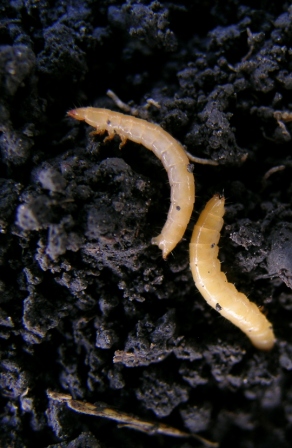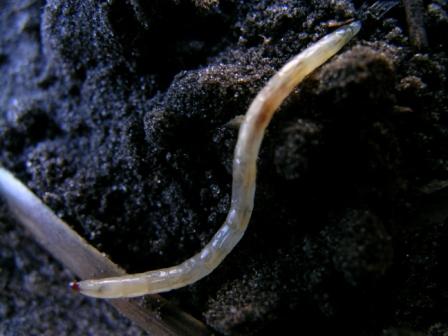Manitoba Insect and Disease Update: June 4, 2013
- John Gavloski, Entomologist
Manitoba Agriculture, Food and Rural Initiatives
Phone: (204) 745-5668
Fax: (204) 745-5690. - Holly Derksen, Plant Pathologist
Manitoba Agriculture, Food and Rural Initiatives
Phone: (204) 750-4248
Fax: (204) 745-5690
Recent Insect and Plant Pathogen Activity
Wheat Streak Mosaic


Figure 1. Wireworm Figure 2. Larva of stiletto fly
Cutworms
Cutworm feeding has been reported from a few fields. Fields near Starbuck and Ste. Agathe have had insecticides applied to control cutworms, and in other instances agronomists are keeping watch over the level of feeding. Dingy cutworms seems to be one of the more numerous species this year. A factsheet showing some of the differnet types of cutworms in Manitoba can be found at: http://www.gov.mb.ca/agriculture/crops/insects/cutworms-field-crops.html
We need your cutworms! Cutworms are needed for a project studying parasitism in our local populations of cutworms. This project aims to gain a better understanding of cutworm parasitoids, and whether there are ways we can create conditions to enhance levels of these parasitoids. So please let us know if you are finding cutworms in any fields. Save some for the study, or we will come to the field to collect them. Please contact Dr. Barb Sharonowski at the University of Manitoba (204-474-7485) or myself (204-745-5668).
Insect Monitoring Programs
Diamondback moth: Counts have generally been low so far from the diamondback moth traps. The highest trap counts have been from Eastern Manitoba. Highest counts are:
Oldenburg - 40
Steinbach - 14
River Hills - 14
Altona - 14
. Emerson - 13
We do not seem to have received any high populations of diamondback moth arriving on any of the winds that have been from the south.
Bertha armyworm: For those who will be putting out traps for adults moths of bertha armyworm, I originally indicated that this week (June 3-9th) would be a good week to try to get the traps out. Based on degree day maps, development of the pupae is delayed this year, and emergence of adult moths should not happen too soon in Manitoba. So if you don't get the traps up this week, the week of June 10-16th would be fine for trap setup.
Aster Leafhopper: Last year aster leafhoppers blew into Manitoba early and aster yellows was a big concern in some crops. So we are keeping track of levels and in Manitoba and in states to the south of us. The good news is that so far there is nothing to report. There have been no reports of aster leafhoppers in Manitoba yet, and in a recent conference call that included entomologists from states in the North Central U.S. nobody was mentioning aster leafhoppers being of noticeable concern. Historically, we have not had 2 bad aster yellows years back-to-back. So we are off to a good start this year to keep this trend.

